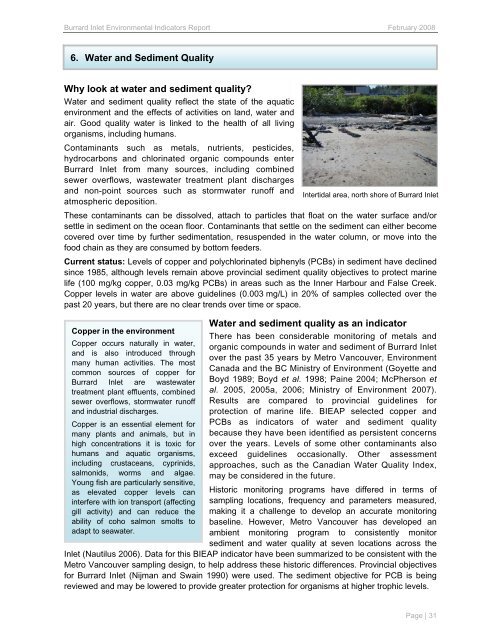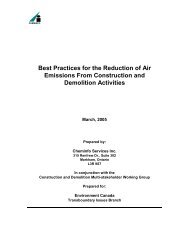Burrard Inlet Environmental Indicators Report - the BIEAP and ...
Burrard Inlet Environmental Indicators Report - the BIEAP and ...
Burrard Inlet Environmental Indicators Report - the BIEAP and ...
You also want an ePaper? Increase the reach of your titles
YUMPU automatically turns print PDFs into web optimized ePapers that Google loves.
<strong>Burrard</strong> <strong>Inlet</strong> <strong>Environmental</strong> <strong>Indicators</strong> <strong>Report</strong> February 2008<br />
6. Water <strong>and</strong> Sediment Quality<br />
Why look at water <strong>and</strong> sediment quality?<br />
Water <strong>and</strong> sediment quality reflect <strong>the</strong> state of <strong>the</strong> aquatic<br />
environment <strong>and</strong> <strong>the</strong> effects of activities on l<strong>and</strong>, water <strong>and</strong><br />
air. Good quality water is linked to <strong>the</strong> health of all living<br />
organisms, including humans.<br />
Contaminants such as metals, nutrients, pesticides,<br />
hydrocarbons <strong>and</strong> chlorinated organic compounds enter<br />
<strong>Burrard</strong> <strong>Inlet</strong> from many sources, including combined<br />
sewer overflows, wastewater treatment plant discharges<br />
<strong>and</strong> non-point sources such as stormwater runoff <strong>and</strong><br />
Intertidal area, north shore of <strong>Burrard</strong> <strong>Inlet</strong><br />
atmospheric deposition.<br />
These contaminants can be dissolved, attach to particles that float on <strong>the</strong> water surface <strong>and</strong>/or<br />
settle in sediment on <strong>the</strong> ocean floor. Contaminants that settle on <strong>the</strong> sediment can ei<strong>the</strong>r become<br />
covered over time by fur<strong>the</strong>r sedimentation, resuspended in <strong>the</strong> water column, or move into <strong>the</strong><br />
food chain as <strong>the</strong>y are consumed by bottom feeders.<br />
Current status: Levels of copper <strong>and</strong> polychlorinated biphenyls (PCBs) in sediment have declined<br />
since 1985, although levels remain above provincial sediment quality objectives to protect marine<br />
life (100 mg/kg copper, 0.03 mg/kg PCBs) in areas such as <strong>the</strong> Inner Harbour <strong>and</strong> False Creek.<br />
Copper levels in water are above guidelines (0.003 mg/L) in 20% of samples collected over <strong>the</strong><br />
past 20 years, but <strong>the</strong>re are no clear trends over time or space.<br />
Copper in <strong>the</strong> environment<br />
Copper occurs naturally in water,<br />
<strong>and</strong> is also introduced through<br />
many human activities. The most<br />
common sources of copper for<br />
<strong>Burrard</strong> <strong>Inlet</strong> are wastewater<br />
treatment plant effluents, combined<br />
sewer overflows, stormwater runoff<br />
<strong>and</strong> industrial discharges.<br />
Copper is an essential element for<br />
many plants <strong>and</strong> animals, but in<br />
high concentrations it is toxic for<br />
humans <strong>and</strong> aquatic organisms,<br />
including crustaceans, cyprinids,<br />
salmonids, worms <strong>and</strong> algae.<br />
Young fish are particularly sensitive,<br />
as elevated copper levels can<br />
interfere with ion transport (affecting<br />
gill activity) <strong>and</strong> can reduce <strong>the</strong><br />
ability of coho salmon smolts to<br />
adapt to seawater.<br />
Water <strong>and</strong> sediment quality as an indicator<br />
There has been considerable monitoring of metals <strong>and</strong><br />
organic compounds in water <strong>and</strong> sediment of <strong>Burrard</strong> <strong>Inlet</strong><br />
over <strong>the</strong> past 35 years by Metro Vancouver, Environment<br />
Canada <strong>and</strong> <strong>the</strong> BC Ministry of Environment (Goyette <strong>and</strong><br />
Boyd 1989; Boyd et al. 1998; Paine 2004; McPherson et<br />
al. 2005, 2005a, 2006; Ministry of Environment 2007).<br />
Results are compared to provincial guidelines for<br />
protection of marine life. <strong>BIEAP</strong> selected copper <strong>and</strong><br />
PCBs as indicators of water <strong>and</strong> sediment quality<br />
because <strong>the</strong>y have been identified as persistent concerns<br />
over <strong>the</strong> years. Levels of some o<strong>the</strong>r contaminants also<br />
exceed guidelines occasionally. O<strong>the</strong>r assessment<br />
approaches, such as <strong>the</strong> Canadian Water Quality Index,<br />
may be considered in <strong>the</strong> future.<br />
Historic monitoring programs have differed in terms of<br />
sampling locations, frequency <strong>and</strong> parameters measured,<br />
making it a challenge to develop an accurate monitoring<br />
baseline. However, Metro Vancouver has developed an<br />
ambient monitoring program to consistently monitor<br />
sediment <strong>and</strong> water quality at seven locations across <strong>the</strong><br />
<strong>Inlet</strong> (Nautilus 2006). Data for this <strong>BIEAP</strong> indicator have been summarized to be consistent with <strong>the</strong><br />
Metro Vancouver sampling design, to help address <strong>the</strong>se historic differences. Provincial objectives<br />
for <strong>Burrard</strong> <strong>Inlet</strong> (Nijman <strong>and</strong> Swain 1990) were used. The sediment objective for PCB is being<br />
reviewed <strong>and</strong> may be lowered to provide greater protection for organisms at higher trophic levels.<br />
Page | 31
















